Thursday Oct 30, 2025
Thursday Oct 30, 2025
Thursday, 30 October 2025 03:56 - - {{hitsCtrl.values.hits}}
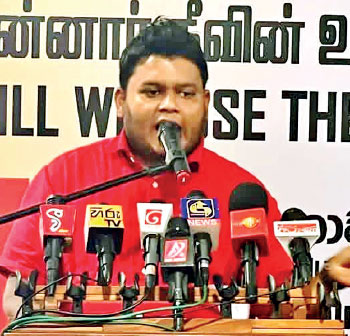
Wasantha Mudalige: patriotism, national liberation, multiethnicity
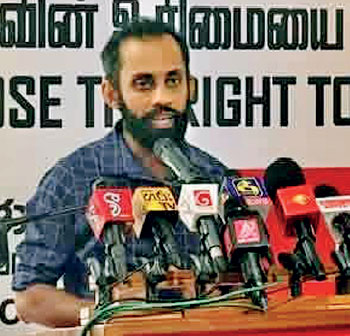
Lahiru Weerasekara, ex-student leader, Aragalaya figure, PSA
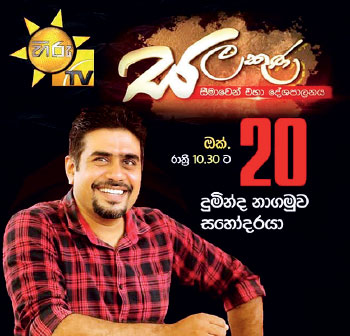
Duminda Nagamuwa: How the JVP became the new Right
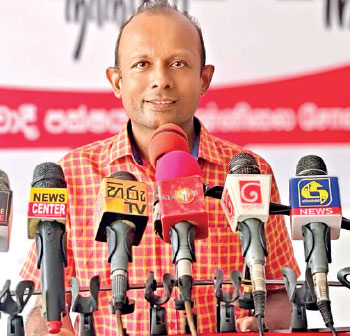
Pubudu Jayagoda, unbeatable by any JVP-NPP leader or Minister in a TV debate
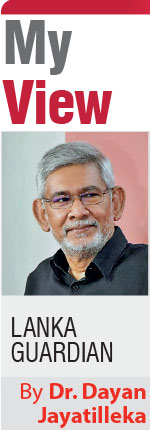 Sri Lanka has witnessed many assassinations of elected political representatives-- elected executives and legislators-- but apart from that of Prime Minister SWRD Bandaranaike in 1959, they were during the two civil wars North and South, and the killings were by armed anti-state organizations the LTTE and the JVP.
Sri Lanka has witnessed many assassinations of elected political representatives-- elected executives and legislators-- but apart from that of Prime Minister SWRD Bandaranaike in 1959, they were during the two civil wars North and South, and the killings were by armed anti-state organizations the LTTE and the JVP.
The murder of Lasantha Wickramasekara, the elected Chairperson of Weligama Pradeshiya Sabha, is different. It didn’t take place in the context of a civil war. And, unlike the sporadic murders of municipal councillors (Wickramasekara was a Chairman) over decades, it took place while he was discharging his duties as an elected legislator, not while he was off-duty in a private locale.
Speaking in Parliament within hours of the shooting, the Minister of Public Security Ananda Wijepala labelled the victim as a gangster and the killing as an inter-gang shooting. This alacrity contrasted with the statement of a French Minister who refused to say anything about the perpetrators of the Louvre robbery on the public record because it had only been three days (at that time) since the crime, and investigations needed more time for a clear picture to emerge.
In Weligama, for the first time, an alleged gangster was killed when he was functioning in his capacity as an elected politician, a chairperson of a representative institution, and in broad daylight, with his staff and public in proximity on the premises. It is as if the killers did not want to murder Lasantha Wickramasekara, so-called gangster, but rather to murder Lasantha Wickramasekara the Chairman of the Weligama Pradeshiya Sabha.
Lasantha was a member of the Samagi Jana Balavegaya, the main parliamentary Opposition, which has never been tainted by association with gangsterism and is simply not a credible target for a gangland killing.
However, the SJB does have a feature which could make it a target of ex-military mercenaries and/or gangster triggermen. It has been winning or heading winning coalitions at a string of recently held Multi-Purpose Cooperative Society elections, as well as a clutch of earlier-held Pradeshiya Sabha elections. NPP representation on most of those recently-elected MPCS Executive Boards has been zero.
The contemporary history of Latin America shows that drug cartels have carried out numerous assassinations of politicians who aren’t themselves gangland rivals but were likely to succeed at municipal, regional or national levels. Who paid, persuaded or induced the cartel triggermen to assassinate those politicians and occasionally take the fall, is guessed at by the public. Similarly, ‘Dubai Lokka’ and his criminal network could have served as intermediary and ‘laundromat’ for a political contract killing.
The assassination of Lasantha Wickremasekara triggered a memory in me: it was an exact replica of the JVP’s killing of Prof Stanley Wijesundara, the University of Colombo’s Vice-Chancellor, in his office on campus, in a daylight shooting.
Congenital lying, political Mafia-ism
I have reason to disbelieve when any JVPer (or JVP-puppet NPPer) expresses his/her view on the identity of a killer. The first political murder by the JVP during its second insurrection in the 1980s was in December 1986. It was of Daya Pathirana, young radical leftist leader of the Independent Student Union of Colombo University. Pathirana was the JVP’s main rival in the university arena.
The date of the killing, a good half-year before the Indo-Lanka Accord and 1½ years from the 13th amendment, disproves any spin that it was a matter of ‘patriots’ vs ‘traitors’. Pathirana being a militant anti-UNP activist also demonstrates that the JVP’s first killing was not targeted at the ruling UNP which the JVP correctly accused of responsibility for its armed uprising by postponing Parliamentary elections and unfairly proscribing the party.
Pathirana was killed because he was a competitor. The JVP since its inception, is intolerant not only of armed enemies but of unarmed critics and competitors. It remains congenitally monopolistic, and that has nothing to do with Marxism-- it is mere political Mafia-ism.
Pathirana and a fellow university student, Somasiri (nicknamed ‘V-C’), were invited for a discussion by JVP students, grabbed on the sidewalk and bundled into a van, taken to an island off Piliyandala, stripped to their underwear, and had their throats cut. For good measure Pathirana had the back of his head caved in. Somasiri survived. It was the night of a full moon and passing pilgrims were able to catch a glimpse of the gruesome goings-on, and therefore the JVP killer-gang abruptly abandoned the task of cutting Somasiri’s throat. Hospitalized, he made a full statement to the Police that the killers were JVP, mostly from the Jayewardenepura campus, and had grilled Daya Pathirana under torture about – among other topics--my whereabouts (as well as those of a female ISU leader).
After the killing of Daya Pathirana the JVP insisted that the atrocity had been perpetrated either by UNP Minister Gamini Lokuge or by “Dayan Jayatilleka ge Vikalpa Kandayama” (Dayan Jayatilleka’s Vikalpa Group). Pathirana and the ISU had an overlap and loose affiliation with the Vikalpa Kandayama, and the murder was sought to be spun by the JVP as an internecine killing. Unfortunately for the JVP, the ridiculous charges never flew. Instead, Daya Pathirana’s enraged fellow students (who had de-briefed survivor Somasiri) took the battle to the JVP, imposing terminal retributive justice.
That didn’t stop the surviving JVP including ‘Big Brother’ persisting until a few years back to vainly spread the Big Lie of an ‘internecine killing’-- the exact equivalent and precursor of the ‘inter-gang killing’ of Weligama’s Lasantha Wickramasekara.
Left continuity
The electoral elimination of the left parties at the 1977 General Election did not result in a collapse of leftist ideology and influence in Sri Lanka. How so? The most dramatic symbolic recognition of the continued influence of leftism after 1977 was when the new draft Constitution of 1978 was presented to President JR Jayewardene. He used his fountain pen to make a significant amendment, adding the adjective ‘Socialist’ to the definitional nomenclature of Sri Lanka as a state and country. That seems a gratuitous gesture but JR was sagacious enough to understand that ‘socialism’ was not primarily a question of economic model, but of values and virtues, aspirations and ethos.
It wasn’t solely JR’s sagacity that caused his leftward nod. It was the fact that unlike at the present time, in 1970-1977 the parties in Government (including the SLFP) had their own left dissidents within them; there was an anti-Government left outside parliament; and a non-government critical left leading the intelligentsia.
Offhand, here’s a list:
1. The Trotskyist left, led by Bala Tampoe and Edmund Samarakkody which broke with the LSSP in 1964 over the entry into the Coalition Government.
2. The Maoist Left led by N Sanmugathasan which broke with the Communist Party on ideological issues of an international character, also in 1964.
3. The JVP, which had been smashed by the State after its adventurist 1971 insurrection but recomposed in the jails, while generating a Maoist breakaway, the Janatha Sangamaya.
4. The non-JVP radical New Left (‘Mitipahara’, ‘Nava Lanka Communist Party’, etc.) critical of the JVP but committed to revolution, which emerged after or sustained themselves despite the ghastly repression witnessed in 1971. Some had been contemporary competitors of the JVP (Dharmasekara Group), others were post-1971. (Despite age discrepancy, Dayapala Tiranagama, Kalyananda Tiranagama, Rohan Samarajiva and I belonged in this space.)
5. The leftwing dissidents who opted to remain within the LSSP and CPSL (e.g., Vasudeva Nanayakkara and Sarath Muttetuwegama) and the SLFP (Kumar Rupesinghe’s Maoist Janavegaya group).
6. The independent intellectual liberal-Left, supportive of the UF victory of 1970 but critical of the Government from 1971-72 onwards. The MARGA Institute, the Center for Society and Religion, and the Social Scientists Association (of which I was a founder-member) were all formed during the United Front Govt and were nodes of critical counter-discourse. Leading UF Ministers were openly critical of MARGA, which had apart from its development research, published Frantz Fanon, Andre Gunder Frank, William Hinton and Ernest Mandel in Sinhala translation. Fr Balasuriya’s CSR sharply critiqued the UF Govt’s rightward economic shift.
These rivulets kept the left and progressive cause going outside of, independent of and critical of the government, seamlessly moving into the post-1977 phase (supported by Mervyn de Silva’s Lanka Guardian), undeterred by the electoral collapse of the LSSP and CPSL.
The governing JVP-NPP is neither leftist, nor has a dissenting leftwing within. There’s no slew of radical New Left groups challenging the government. There is no critical intellectual left, institutional or informal, outside this Government (barring the FSP-linked PSA and the CPSL-linked Asia Progress Forum). Pro-NPP intellectuals criticize the global system, ignoring or excusing Anura’s abject betrayal.
The AKD-JVP-NPP government discredited leftism as a label so badly, it could destroy Leftism as a brand.
Three-headed Right
Sri Lanka’s Right is three-headed, like the mythical Cerberus. We have the ruling Right, AKD and the JVP-NPP with its unaltered IMF economic austerity; sellout to the private foreign creditors on debt repayment terms; giveaway of lands and strategic assets to foreign corporates; avoidance of BRICS and SCO; deletion of references to Israeli Occupation of Palestinian lands and people; and accommodation of an exhibitionistic-aggressive Zionist presence. It represents the interests of the dependent neo-comprador big capitalists.
Then there are two right-wing tendencies in the Opposition space, either one of which will influence the next Government, while the other influences the next Opposition:
 The Economic Right, which seeks to eliminate state enterprise (including Sri Lankan Airlines) in the economy, build roads to India, economically integrate with Tamil Nadu, and adopt a pro-US-UK-NATO foreign policy. It is embedded within the UNP and the SJB –though the latter has a progressive-centrist leader, Sajith Premadasa, who verges on social democracy.
The Economic Right, which seeks to eliminate state enterprise (including Sri Lankan Airlines) in the economy, build roads to India, economically integrate with Tamil Nadu, and adopt a pro-US-UK-NATO foreign policy. It is embedded within the UNP and the SJB –though the latter has a progressive-centrist leader, Sajith Premadasa, who verges on social democracy.
 The Ethnoreligious Right, mostly Islamophobic and pro-Israeli. These ultranationalists hover around the SLPP seeking to dominate it as it did Gotabaya’s disastrous SLPP government, though Namal Rajapaksa himself is a moderate-nationalist with a center-left self-identity (like his father).
The Ethnoreligious Right, mostly Islamophobic and pro-Israeli. These ultranationalists hover around the SLPP seeking to dominate it as it did Gotabaya’s disastrous SLPP government, though Namal Rajapaksa himself is a moderate-nationalist with a center-left self-identity (like his father).
 The Economic Right agenda dominating SJB-UNP govt policy means patriotic Southern rebellion.
The Economic Right agenda dominating SJB-UNP govt policy means patriotic Southern rebellion.
 The Ethnoreligious Right agenda dominating SLPP govt policy means global isolation/ encirclement/Northern unrest.
The Ethnoreligious Right agenda dominating SLPP govt policy means global isolation/ encirclement/Northern unrest.
JVP’s organic crisis
The JVP-NPP in 2019-2020 did not have the mass base that the LSSP-CPSL had from the 1940s through to the General Election of 1970. In 2024 it did. That mass support was not an organically evolved electoral base such as the LSSP-CPSL historically had. It was conjunctural, situational, episodic. It was obtained not through organic growth but by smart manoeuvre, speedy mobility which enabled accurate positioning after the Aragalaya, while Sajith Premadasa’s SJB dithered.
However, manoeuvre and mobility can only get you so far, and that too only in the Opposition, not in office. Even when he was elected President, AKD got only 42%-43% of the vote; the only Lankan president not to reach 50%.
In Government, successful politics is a ‘prolonged war of position’ of the accumulation of social forces. The JVP-NPP has not been able to grow organically while in office, because of its structure and economic policy. Dodging/delaying the Provincial Council elections deprives it of an opportunity for electoral solidity.
Despite its organic electoral base, the LSSP-CPSL shrivelled between 1970 and 1977 because of mass economic hardship. So too will the JVP-NPP, especially without an organic electoral foundation.
Raj Sivanathan nails it:
‘…the defeats in a series of key southern districts, including Kelaniya, Beruwala and Homagama, point to a deeper truth: the NPP’s grassroots strength is slipping. In at least 9 out of 14 co-operative contests, NPP backed groups suffered defeat at the hands of opposition or independent alliances…The co-operative results demonstrate that even in traditional left-leaning areas, the party’s support has eroded amid inflation, cost of living pressures and stalled reforms.’
Unlike an open, truly mass (e.g. social democratic) party, nowhere in the world is a cadre-based ‘vanguardist’ party sustainably successful electorally in a competitive multi-party democracy. 2024 was an exceptional episode in the Aragalaya’s wake.
The JVP is relying on its old cadre-based model and institutional culture to keep it on top, though its performance at the local authorities’ election shows an unprecedentedly sharp drop in the popularity in a first year in office. Slow-motion electoral snap-back is underway.
AKD-NPP 2024 was an electoral ‘bubble’, the political version of a financial bubble. By 2029 the Opposition will catch the JVP-NPP in a center-right (SJB-UNP)/center-left (SLPP) pincer.
The next Left
It is hardly big, but has proved its capacities in the Aragalaya as ‘motor force’ and spearhead. I refer to the Jana Aragalaya Vyaparaya (JAV) or People’s Struggle Movement (PSM) partnered with the Frontline Socialist Party (FSP).
FSP Educational Secretary Pubudu Jayagoda cannot be beaten in a TV debate by any JVP leader or NPP Cabinet Minister—and none dares try.
Meanwhile, the public presentation I found to be the most strikingly impressive of this year (so far) is by Aragalaya student leader and hero Wasantha Mudalige, the only Aragalaya personality who has a documentary on him on international TV (Australia’s SBS). On the proposed projects in Mannar and Trincomalee which have triggered protests, the presentation by FSP-PSA’s Mudalige is a powerfully-delivered, deep-cutting, superb fusion of political economy, fact-based logical analysis, environmentalism and geopolitics, all in 20+ minutes. (https://www.facebook.com/share/v/14f9VuyxoC1/)
Though the JVP-NPP is anti-racist, it is utterly, unprecedentedly unpatriotic and an enemy of national liberation as demonstrated by its secret pacts with India and sellout to Indian big corporates as well as private foreign creditors. In contradistinction, the FSP-PSA has succeeded in combining patriotic national liberation themes while cutting across ethnonational and ethnoreligious boundaries, unifying all communities in any area in a combined struggle. The multiethnic militancy in the Eastern province in the late 1980s of Kumar Gunaratnam, FSP founder-leader, is probably an inspiration.
On a recent TV program, Duminda Nagamuwa, former university student leader, FSP-PSA figure, and memorable orator during the Galle Face Aragalaya, shocked the show’s anchors by venturing a radical proposition: the JVP was no longer a left party. (https://www.facebook.com/share/v/1Ar1gGBhbh/)
Recalling that the FSP broke from the JVP way back in 2011 because of its rightist tendencies and absence of internal democracy, Nagamuwa explained that the Aragalaya was so powerful it sent the Establishment reeling, with almost all parties including the main Opposition finding themselves off-balance. With strongman Gotabaya ousted by the civic movement, the big corporates found a governing alternative in the JVP-NPP, while the latter found patronage. The JVP-NPP is now the new party, the new vehicle and agency of the big bourgeoisie, Sri Lankan and foreign.
The implosive electoral collapse of the JVP-NPP in 2029 will be the FSP-PSA’s chance to emerge as the main left party; the left Opposition to either the SJB or SLPP in Government. Sri Lanka’s last Left standing today –active, engaged in heroic political praxis--will be tomorrow’s Left.
With Human Rights Watch correctly criticizing Sri Lanka for tax-breaks for the superrich while starving public schools of funds and charging fees instead, whoever we elect the next President and PM/Government, we need a democratic Socialist-inspired Opposition, or as a major player in Opposition, in Parliament and Provincial Councils. (https://www.hrw.org/report/2025/10/14/tax-giveaways-struggling-schools/how-low-taxes-drove-sri-lankas-economic-crisis)
(https://dayanjayatilleka.webflow.io/)
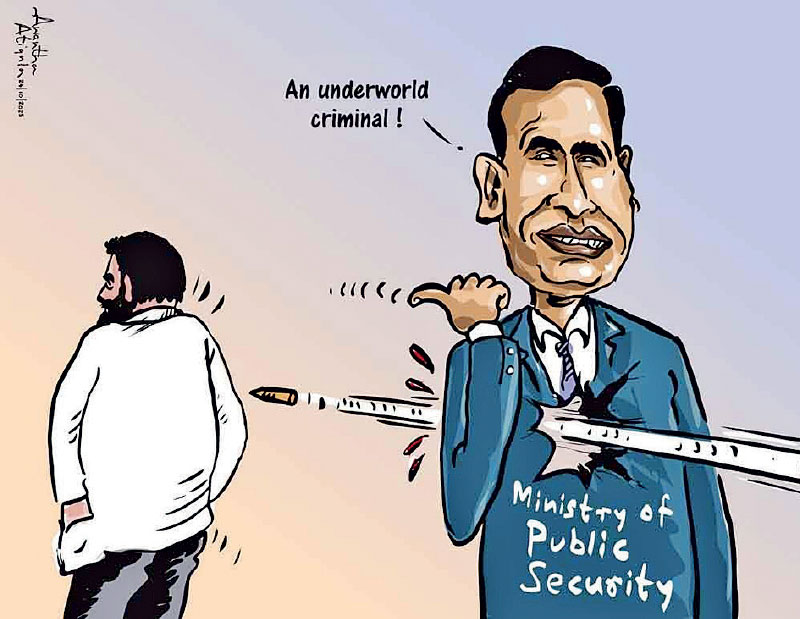
Sympathy, empathy and speedy investigation
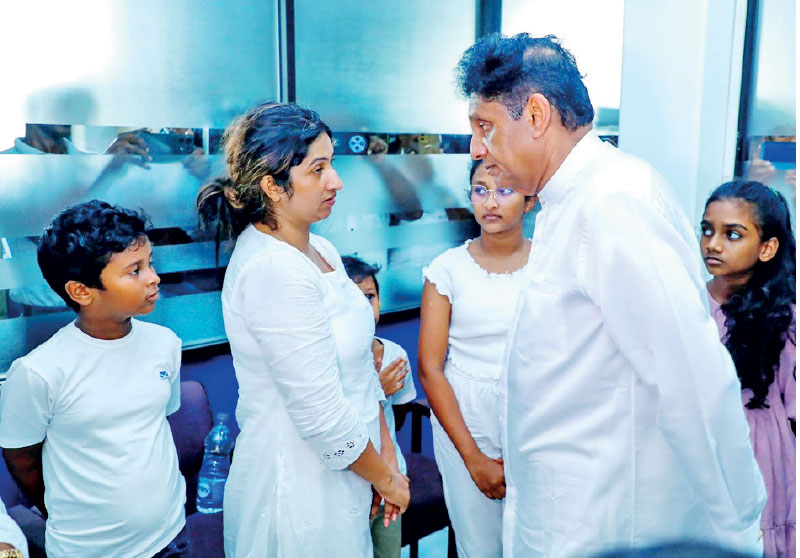
SJB Leader Premadasa condoles with Lasantha Wickremasekara’s family
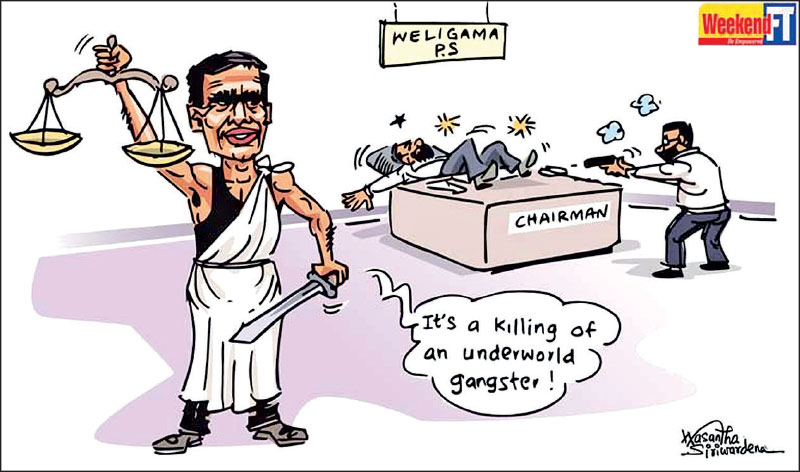
Condolences, condemnation, sympathy and empathy from the Minister!